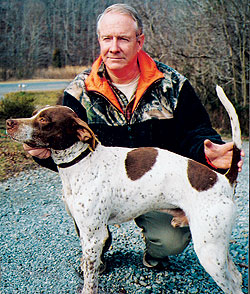By James B. Spencer
 Gary Satterfield |
"In introducing them to water," Gary said, "perhaps the most common mistake novices make with pointing breeds is starting when the puppies are too young. I wait until they're at least four months old, when they have better balance and coordination. Another common mistake is using force of any kind in this process."
Gary stressed that, before being introduced to water, the pup should be well socialized and bonded with the person training him. He should obey the "here" command and be comfortable with a strap collar and checkcord.
Gary begins by taking the pup for walks along a narrow stream with very shallow water near the shore. He wades around in the shallows, encourages the pup to follow him, and praises him lavishly when he does. It may take several sessions before the pup ventures into the water, but once he does, a few more hikes will have him romping around in the shallows and enjoying it.
"Of course," Gary said, "we're talking about summertime; warm weather, warm water. A cold-water shock treatment could permanently intimidate the puppy, making him fear water the rest of his life."
If the puppy enjoys retrieving on land, as soon as he begins to splash around in the shallows, Gary starts tossing a small bird-scented retrieving dummy a short distance in shallow (non-swimming) water for the puppy to retrieve.
Then he begins leading the puppy across the stream in various places where the youngster can wade all the way. Gary encourages him with the "here" command, and uses the checkcord to guide, but not drag him across. He praises the puppy all the way across, and especially after they both reach the far side.
"Without the checkcord," he said, "the puppy might learn to escape by running off, which could create all sorts of training problems later on. I use the checkcord here purely for guidance and control. I use the "here" command and praise to encourage the pup to follow me willingly."
As the puppy ages and becomes increasingly more comfortable wading across the stream, Gary begins leading him across in places where he has to swim a few strokes in the middle. Here, too, Gary praises the puppy as he swims and when he reaches the shallows again. In subsequent sessions, he gradually lengthens the distance the pup has to swim.
"Once the youngster has started racing into the water and swimming across eagerly, if he enjoys retrieving on land, I start tossing live hobbled birds, pigeons or quail, across the stream onto the far shore for the pup to retrieve. I don't toss them into the water, because retrieving birds soaked to the skin encourages chewing, which quickly turns into hardmouth."
| Introducing Your Puppy To Water | 

Don't miss tips for your retriever here, or your spaniel here.
|
|
Live, hobbled pigeons and quail really excite the puppy, but only if he sees them thrown.
This is no time for blind retrieves. Thus Gary makes sure the pup is watching him when he throws the bird.
"To have a dependable retriever, whether on land or in water," Gary added, "you should force-break him, but not until he's between one and two years old."
This tip is from Gary Satterfield of Satterfield Kennels, 2130 Old Mountain Road, Thomasville, NC 27360; (336) 472-6227; satterfieldkennels@yahoo.com. Gary has been training pointing breeds professionally for 33 years; he specializes in producing gun dogs for grouse and quail hunters.






